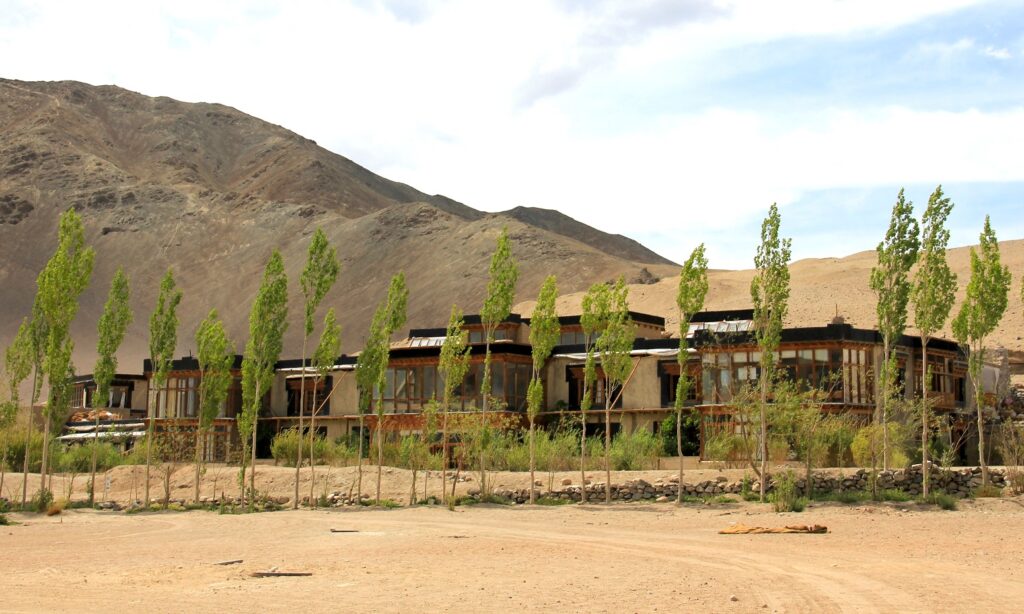The SECMOL (Students’ Educational and Cultural Movement of Ladakh) School building features rammed-earth construction and passive solar architecture. The region has a cold desert climate with temperature variation from 20°C (68°F) in summer to -30°C (-22°F) in winter. Luckily this area has over 300 sunny days per year, so the sun is a reliable energy source.
 The SECMOL campus is home to about 70 students, a few staff members, and volunteers who live, work, and study there. It is maintained and, to a large extent, run by students themselves. The campus comprises one large school building, three residential houses, and 20 small cell rooms apart from other necessary infrastructure.
The SECMOL campus is home to about 70 students, a few staff members, and volunteers who live, work, and study there. It is maintained and, to a large extent, run by students themselves. The campus comprises one large school building, three residential houses, and 20 small cell rooms apart from other necessary infrastructure.
 The school building was designed by Sonam Wangchuk – a locally born engineer-turned-architect and Ramon Magsaysay.
The school building was designed by Sonam Wangchuk – a locally born engineer-turned-architect and Ramon Magsaysay.
 The construction started in 1994 and was inaugurated in 1998 by Dalai Lama. In 2016, the building was judged one of the best nine buildings having earthen construction by the jury of the international TERRA Award.
The construction started in 1994 and was inaugurated in 1998 by Dalai Lama. In 2016, the building was judged one of the best nine buildings having earthen construction by the jury of the international TERRA Award.
 The structure is sunken one meter below the ground on the north side. Since the earth’s temperature at this depth is relatively warm in winter and cool in summer, it helps create comfortable living conditions inside. It also helps get the primary building material, the earth, on-site, thus eliminating the need for long-range transportation. Another advantage of this technique is that there was no debris to be thrown away when the construction finished.
The structure is sunken one meter below the ground on the north side. Since the earth’s temperature at this depth is relatively warm in winter and cool in summer, it helps create comfortable living conditions inside. It also helps get the primary building material, the earth, on-site, thus eliminating the need for long-range transportation. Another advantage of this technique is that there was no debris to be thrown away when the construction finished.
 The building is oriented to face south, with its main facade having large windows on this sun-facing side. It keeps the building warm in winter. The rammed earth walls act as heat banks, so the structure absorbs heat from the sun during the day, stores it, and then releases it to the rooms at night.
The building is oriented to face south, with its main facade having large windows on this sun-facing side. It keeps the building warm in winter. The rammed earth walls act as heat banks, so the structure absorbs heat from the sun during the day, stores it, and then releases it to the rooms at night.
 In brief, the following are some main features that keep the building warm in winter:
In brief, the following are some main features that keep the building warm in winter:
- Windows have been provided on the south side as the sun moves low in the southern winter sky, keeping the building warm.
- Greenhouses are attached to the south side to trap the sun’s heat. In winter, large plastic sheets are rolled down to make big greenhouses that work as solar collectors. In summer, the plastic sheets are rolled up to prevent overheating.
- Skylights are covered with glass or clear plastic to keep warm air indoors.
- Thick earthen walls and floors help to store collected heat.
- Insulation has been provided on the roof, outer walls, and some places under the floor.
- Natural lighting has been provided in abundance, so electricity is not needed for light in the daytime.
- The roof is insulated with wood waste generated during the construction to stop heat loss.
 The success of the building can be gauged from the fact that when the outside temperature is -25°C (-13°F) in winter, the inside temperature remains +14°C (57°F). The building has no electricity connection or requires burning fossil fuels for heating, even during peak winter months.
The success of the building can be gauged from the fact that when the outside temperature is -25°C (-13°F) in winter, the inside temperature remains +14°C (57°F). The building has no electricity connection or requires burning fossil fuels for heating, even during peak winter months.
You can read the original article at hillpost.in

